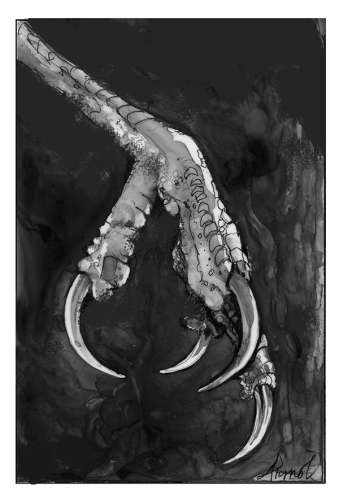
As spring’s crescendo of birdsong mellows now to a steadier summer trill, I listen for melodies I don’t recognize and try to figure out which birds are singing. I look through binoculars at their feathers, the color variations along head and chest, the size of their beaks, the shape of their wings, and the tilt of their tails in my flailing attempts to distinguish one species from another.
Rarely have I considered feet in my casual observations, although this part of a bird’s anatomy can be highly specialized for various uses.
“When you look at the foot of a bird, they’re not all the same,” said Kevin McGowan of the Cornell Lab of Ornithology. “All the birds basically started off with three toes forward, one back. From that, they’ve evolved in a number of different ways for various reasons.”
Birds walk on those toes – not the entire foot. The backward-bending joint we may consider a knee is actually the birds’ ankle. The feet consist mainly of bones and tendons, with very little muscle and few blood vessels.
Songbirds have what McGowan called “generalized all-purpose bird feet.” This group has the most common avian foot arrangement: digit 1 (which McGowan likened to a human thumb) faces backwards; digits 2, 3, and 4 face forward.
Some other birds have two toes forward and two back. A few have only three toes, or a digit 1 that has shrunken to the point of disuse. There are webbed feet and lobed feet and powerfully sharp talons.
Woodpeckers generally have two toes facing forward and two backward in what is called a zygodactyl arrangement. The two forward-facing toes help them climb and cling to trees. The backward-facing toes can rotate sideways to gain a more stable purchase on a tree trunk.
Woodpeckers don’t necessarily need both backward-facing toes, however, and some species – including the black-backed woodpecker and the aptly named American three-toed woodpecker – have only three toes: two forward and one back.
“It’s simply a matter of variations in evolution to serve a similar function,” McGowan said.
This is true of aquatic birds, too. While most swimmers – including ducks, geese, loons, and gulls – have fully webbed feet, a few do not. This includes members of the grebe family, whose front three toes are lobed rather than webbed. These lobes spread out as the grebes paddle – or dive – through the water, then contract as the foot moves forward, creating a more streamlined effect.
“They have almost as much surface area as a fully-webbed foot,” McGowan said. “They solved the same problem, but in a different way.”
Duck and goose feet are palmately webbed, meaning there is full webbing between the front three toes, but the back toe is not webbed. Other swimmers, like cormorants, have totipalmate feet, where digit 1 is slightly sideways, and there is webbing between each toe. Like the lobed-toed grebes, cormorants can compress their feet to reduce water resistance during the forward stroke.
Other water birds, like plovers and herons that spend time standing on soft surfaces like sand and mud, have partially webbed, or semipalmate, feet; there is a bit of webbing closest to where the digits connect to help distribute the birds’ weight and prevent them from sinking as they wade or run along the sand.
Ruffed grouse feet also create buoyancy – in snow, rather than sand. In the winter, grouse grow fringe-like projections along the front-facing digits to create something like a snowshoe.
Raptors use their feet as weapons. “They have particularly strong feet. And they have big, pointy toenails,” said McGowan. “A lot of hawks kill their prey by grabbing it and putting the back toe up through the animal into the heart.”
Some hawks, including Cooper’s hawks and sharp-shinned hawks, have very long legs, allowing them to hold their prey away from them – so a seized bird can’t peck at its captor’s face.
Peregrine falcons use their disproportionately large feet like fists, striking their prey in midair, then catching it as it falls. Owls and ospreys have one toe – the fourth digit – that faces backward while perching but can swing to the side, forming a wider gripping surface to pluck prey out of air or water.
Raptors, like songbirds, also use their feet to perch, which involves an involuntary mechanism that McGowan likens to marionette strings.
When a songbird lands on a perch, its ankles flex. In each foot, a pair of tendons – one moving the front three digits, the other moving the back digit – pulls the toes closed around the perch. Those tendons remain locked until the bird takes off, releasing the ankle and thereby the bird’s grip on the perch – an intricate design for such “all-purpose” feet.

